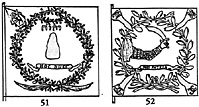 No.51. The Second Color. A red field. Obverse: In the center a white
cloud. Above the cloud Hebrew letters in yellow. Below the cloud a blue
ribbon with the inscription HOC DUCK in yellow. A wreath with light yellow
and golden leaves, and below the wreath, two golden-yellow feathers. In
the upper, inner comer a red lion on a gold shield and above the shield
a gold crown lined red. Coming from the same corner two blue cords. Reverse:
The inscription changes to YEHOVAH.
No.51. The Second Color. A red field. Obverse: In the center a white
cloud. Above the cloud Hebrew letters in yellow. Below the cloud a blue
ribbon with the inscription HOC DUCK in yellow. A wreath with light yellow
and golden leaves, and below the wreath, two golden-yellow feathers. In
the upper, inner comer a red lion on a gold shield and above the shield
a gold crown lined red. Coming from the same corner two blue cords. Reverse:
The inscription changes to YEHOVAH.
No. 52 thru 56 present a problem. In the Triomphes they are described as being taken at Brussels in February 1746 and as being "German". If they indeed were taken at Brussels they could not be "German" as no "German" regiments were part of the garrison. They would then belong to the Holland regiments listed under Nos. 35 and 36 above.
If they are "German", they were not taken at Brussels; however, three "German" regiments did become prisoners of war when the city of Namur surrendered to the French in October 1746: Isenberg (Groningen), Oyen (gelderland) and Leiningen (Holland). Since two of these regiments were part of the establishment of provinces which began with the letter "G", it might help explain the mirrored "G" in No. 52. I tend to lean toward the "German" designation. The design of these colors resembles that of colors carried by regiments from some North German states such as Hanover.
No.52. A white field with light buff comer flames. Within each flame a mirrored "G" in gold. In the center a greywhite cloud from which is issuing an armored arm holding a sword. The armor is steel colored with gold bands and rivets. The plate on the inside of the elbow is red edged in gold. The hand is Caucasian- flesh colored. The sword has a silver blade with gold hilt and grip. The wreath is gold and tied together with a red ribbon. The large ribbon is blue with the inscription PRO PATRIA in gold.
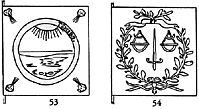 No. 53. A red field. In the center a white blade sword with gold hilt
and grip. On either side of the sword a gold scale with a white cross piece.
The wreath is gold and tied together with a blue ribbon. The large ribbon
is blue with the inscription in gold (Unfortunately, the inscription is
blurred and only the word ET can be made out.)
No. 53. A red field. In the center a white blade sword with gold hilt
and grip. On either side of the sword a gold scale with a white cross piece.
The wreath is gold and tied together with a blue ribbon. The large ribbon
is blue with the inscription in gold (Unfortunately, the inscription is
blurred and only the word ET can be made out.)
No.54 & 55. A white field with a Caucasian-flesh colored cherub's face in each corner. In the center a white sun edged gold with golden rays in a light blue sky. The earth is a mixture of light earth tones and grays. This scene is surrounded by a blue ribbon edged gold with the inscription (TIMIDE) in gold.
 No.56. Two colors of this pattern. One has a white field with light
buff comer flames, while the other has a light buff field with white comer
flames (possibly the Principal and Second Colors of the same regiment).
In the center a gray-white cloud from which is issuing an armored arm holding
a sword. The armor is steel colored with gold bands and rivets. The piece
on the inside of the elbow is red edged in gold. The hand is Caucasian-
flesh colored. The sword has a silver blade, and gold hilt and grip. The
wreath is gold and tied together with a red ribbon. (Note: The Second Color
has no ribbon tying the wreath together.) The large ribbon is blue with
the inscription (PRO PATRIA) in gold.
No.56. Two colors of this pattern. One has a white field with light
buff comer flames, while the other has a light buff field with white comer
flames (possibly the Principal and Second Colors of the same regiment).
In the center a gray-white cloud from which is issuing an armored arm holding
a sword. The armor is steel colored with gold bands and rivets. The piece
on the inside of the elbow is red edged in gold. The hand is Caucasian-
flesh colored. The sword has a silver blade, and gold hilt and grip. The
wreath is gold and tied together with a red ribbon. (Note: The Second Color
has no ribbon tying the wreath together.) The large ribbon is blue with
the inscription (PRO PATRIA) in gold.
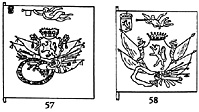 No. 57 thru 59 probably represent the Colonel's Colors of the four Swiss
regiments Dutch service. No. 57 represents the pattern of two colors taken
at Brussels in February 1746 which Dr. F. G. deWilde of the Netherlands
describes as being Colonel's Colors of Swiss regiments. Elements of all
four regiments were part of the garrison of the city. No. 57 probably belongs
to IR Sturler and IR Planta. Nos. 58 and 59 are very similar to No. 57
and are probably the Colonel's Colors for LR Constant ad LR Hirtzel.
No. 57 thru 59 probably represent the Colonel's Colors of the four Swiss
regiments Dutch service. No. 57 represents the pattern of two colors taken
at Brussels in February 1746 which Dr. F. G. deWilde of the Netherlands
describes as being Colonel's Colors of Swiss regiments. Elements of all
four regiments were part of the garrison of the city. No. 57 probably belongs
to IR Sturler and IR Planta. Nos. 58 and 59 are very similar to No. 57
and are probably the Colonel's Colors for LR Constant ad LR Hirtzel.
No.57. A white field. In the center a red lion with blue tongue and claws on a gold shield. Above the shield a gold crown lined red. On both sides of the shield, a cornucopia in gold and hang ing from each a gold cord and tassel. Surrounding the center design is a trophy of arms containing on the right from top to bottom a red flag, a gray flag, a brown rammer staff with black sponge, two brown shafts with silver heads, a powder scoop with a brown shaft and gold scoop, a halberd with a brown shaft and silver head, a white flag, a gold cannon barrel, beneath the cannon barrel are two Caucasian-flesh colored items, above the cannon barrel is a steel-colored drum with white drumhead, to the left of the drum is steel-colored armored armpiece lined red with gold bands and rivets and at the inside of the elbow a red patch lined gold to the left of the armpiece is a steel-colored drum with a white drumhead, a silver and black device, a silver de vice, a gold cannon barrel, below the barrel a gold trumpet and a gold mace, to the right of the barrel a steel-colored shield with gold studs, below this shield another steel-colored shield over which pass three gold cords.
All finials, cords and tassels of the flags in the trophy are gold. To the lower left is a steel- colored ribbon (?) with the inscription NOBILITAS SULA EST ATOUE UNITA VIRTUS in gold. Above the shield and trophy of arms is Fame in Caucasian-flesh color. She is blowing a gold trumpet which has a red banner which appears to contain a gold lion. In the upper, inner comer is the coat-of-arms of the province of Holland: a gold lion on a red shield with a gold crown lined red above.
No.58. A white field. In the center a red lion on a gold shield. Above the shield a gold crown with silver pearls on the crown points. On either side of the shield a gold cornucopia containing red, blue and white flowers. Surrounding the center device a trophy of amps consisting on the right of a red flag over a gray-white flag, and on the left a gray-white flag over a red flag. The finials of all flags are gold. On the lower right a number of weapons and artillery equipment all with brown shafts and silver blades. The cannon barrel is dark silver/gray, the helmet has gold bands on the neck piece and visor and appears to have a light red plume. The large ribbon is blue without inscription. Above the shield and trophy is Fame colored Caucasian-flesh with a red ribbon around her waist and blowing a gold trumpet. In the upper, inner comer a gold lion on a red shield above which is a gold crown lined red.
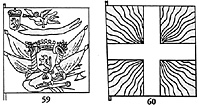 No.59. Identical to No. 58 except the cornucopia contains red, blue
and silver flowers. The lower right weapons have gold shafts and blades.
The drum is dark silver/gray, as is the helmet which has gold bands around
the neck piece and visor. Below the cannon barrel are two light red ribbons
(?). Above the crown is another blue ribbon without inscription.
No.59. Identical to No. 58 except the cornucopia contains red, blue
and silver flowers. The lower right weapons have gold shafts and blades.
The drum is dark silver/gray, as is the helmet which has gold bands around
the neck piece and visor. Below the cannon barrel are two light red ribbons
(?). Above the crown is another blue ribbon without inscription.
No.60. 11 Colors of this pattern were taken at Brussels in February 1746. Dr. deWilde attributes these to IR Sturler. A white center cross divides the field into quarters. The flames in each quarter are colored clockwise: green, red, blue, yellow, black, white, black, yellow, blue, red, green.
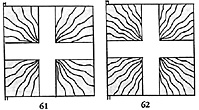 No.61. Two sets of Colors of this pattern were taken at Brussels in
February 1746; one set of 4 colors and another of 7 Colors. Dr.deWilde
attributes the set of 4 Colors to LR Constant. A white cross divides the
field into quarters. The flames in each quarter are colored clockwise:
red, black, red, black, red, black, red.
No.61. Two sets of Colors of this pattern were taken at Brussels in
February 1746; one set of 4 colors and another of 7 Colors. Dr.deWilde
attributes the set of 4 Colors to LR Constant. A white cross divides the
field into quarters. The flames in each quarter are colored clockwise:
red, black, red, black, red, black, red.
The other set of 7 Colors probably belongs to LR Hirtzel. Although Dr. deWilde does not mention this regiment and it is not listed as present at Brussels, the Triomphes illustrates four different color patterns of Swiss regiments. Three regiments are identified by Dr. deWilde. Since there were only four regiments at the time, this must belong to the fourth regiment, Hirtzel A white cross divides the field into quarters. The flames in each quarter are colored clockwise: white, black, red, white, red, black, red.
No.62. 11 Colors of this pattern were taken at Brussels in February 1746. Dr. deWilde attributes these to IR Planta. A white cross divides the field into quarters. The flames in each quarter are colored clockwise: yellow, black, white, black, yellow, black, white, black, yellow.
 Nos. 63 represents Colors which are probably Dutch, but the province
cannot be established with certainty.
Nos. 63 represents Colors which are probably Dutch, but the province
cannot be established with certainty.
No.63. A blue field. In the center a gray-white bird holding a gold branch in its beak. Below the bird a trophy of arms consisting of a silver drum with a white drumhead; on the right a gold flag, gray-white flag and a gold flag from top to bottom; on the left a gray-white flag, a gold flag and a gray-white flag from top to bottom Above the bird a red ribbon without inscription. The whole surrounded by a gold wreath with silver berries tied together with a red ribbon.
More Flags
All Flags: Large size (Warning: Monster file: 1048K!)
Back to Table of Contents -- Courier #65
© Copyright 1994 by The Courier Publishing Company.
This article appears in MagWeb (Magazine Web) on the Internet World Wide Web.
Other military history articles and gaming articles are available at http://www.magweb.com